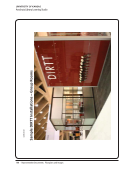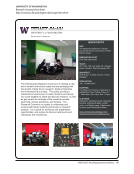SPEC Kit 327: Reconfiguring Service Delivery · 21
Survey Questions and Responses
The SPEC survey on Reconfiguring Service Delivery was designed by Kay Vyhnanek, Scholarly
Communication Librarian, and Christy Zlatos, Subject Specialist Librarian for Architecture &Interior
Design, at Washington State University. These results are based on data submitted by 59 of the 126 ARL
member libraries (47%) by the deadline of June 13, 2011. The survey’s introductory text and questions are
reproduced below, followed by the response data and selected comments from the respondents.
Research libraries face increasing challenges to providing relevant library services to their constituents. As the information needs of
their constituencies have grown, research libraries have changed their service strategy from simply providing sufficient collections
to fulfilling a panoply of user research desires. As the range of services has evolved, so have the locations and methods of service
delivery. In some cases, service points have increased through the opening of a new facility or the need to provide a new type of
service. In other cases, the number of service points has been reduced or consolidated in response to use patterns or budgetary
reductions.
The purpose of this survey is to investigate whether and how ARL member libraries have reconfigured staffed service delivery points
in the main library and in any branches that report to the main library. It explores whether service points and/or branches have been
added, closed, or consolidated the drivers for those decisions the impacts on staff the changes in delivery methods and whether
there have been any collaborations with other institutions or consortia, or outsourcing of service delivery. It also explores user
involvement in the planning for service changes and whether the effectiveness of new service configurations has been assessed.
The survey uses a case study approach to reveal developing patterns, unique applications, and anticipated changes in the physical
or organizational arrangement of service delivery that may be widely adaptable in other libraries so that they can continue to be the
primary information providers for their constituents.
For this survey a service point may be any library-staffed desk, office, or other physical location that is maintained to provide service
to a specific constituent group.
Survey Questions and Responses
The SPEC survey on Reconfiguring Service Delivery was designed by Kay Vyhnanek, Scholarly
Communication Librarian, and Christy Zlatos, Subject Specialist Librarian for Architecture &Interior
Design, at Washington State University. These results are based on data submitted by 59 of the 126 ARL
member libraries (47%) by the deadline of June 13, 2011. The survey’s introductory text and questions are
reproduced below, followed by the response data and selected comments from the respondents.
Research libraries face increasing challenges to providing relevant library services to their constituents. As the information needs of
their constituencies have grown, research libraries have changed their service strategy from simply providing sufficient collections
to fulfilling a panoply of user research desires. As the range of services has evolved, so have the locations and methods of service
delivery. In some cases, service points have increased through the opening of a new facility or the need to provide a new type of
service. In other cases, the number of service points has been reduced or consolidated in response to use patterns or budgetary
reductions.
The purpose of this survey is to investigate whether and how ARL member libraries have reconfigured staffed service delivery points
in the main library and in any branches that report to the main library. It explores whether service points and/or branches have been
added, closed, or consolidated the drivers for those decisions the impacts on staff the changes in delivery methods and whether
there have been any collaborations with other institutions or consortia, or outsourcing of service delivery. It also explores user
involvement in the planning for service changes and whether the effectiveness of new service configurations has been assessed.
The survey uses a case study approach to reveal developing patterns, unique applications, and anticipated changes in the physical
or organizational arrangement of service delivery that may be widely adaptable in other libraries so that they can continue to be the
primary information providers for their constituents.
For this survey a service point may be any library-staffed desk, office, or other physical location that is maintained to provide service
to a specific constituent group.






















































































































































































































